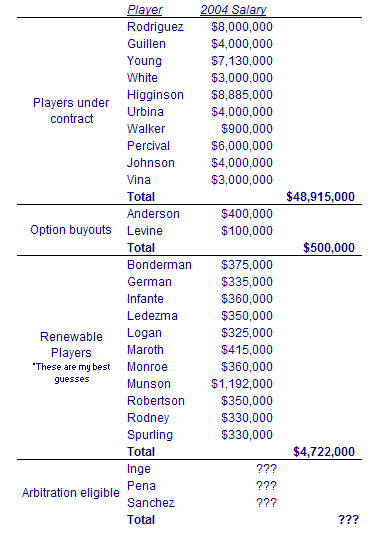As I mentioned in my last post, Adrian Beltre is the first guy that I’ve been disappointed in missing. Adding Glaus, Pavano, and Finley would have been a nice boost to the team, but Beltre was the guy I was most excited about.
First of all, for some reason I thought we had a shot at him. Based on all the local specualtion, reports from national media (Gammons, Rosenthal, etc), and my own hopes it seemed plausible. Beltre was looking for a big long term deal, the Tigers had big money to spend (supposedly) and were eager to make a splash. His former team promptly signed an insurance policy (Kent) because they felt he wouldn’t be coming back.
Assuming the Tigers were interested, which is a big assumption, they were only competing with the Mariners’ and the Dodgers. LA was content to let him walk if they thought he got too pricey. That left the Mariners as the main suitor. The same Mariners who finished with 99 losses and 29 games out of first place. The same Mariners’ who play in Safeco which was the worst hitters park in the American League. Ballpark and winning are two of the common reason we hear about players not coming to Detroit. Seattle manages to lose more games, play in a less conducive hitters environment, and they manage to sign two sluggers. If it all comes down to Detroit not being on the west coast, or Detroit being too cold then Detroit is going to be in a world of hurt for a long time.
This leads me to believe that the Tigers weren’t ever in on Beltre. And really, it isn’t the Tigers’ fault that the media may have exagerated their interest. But what I don’t get is why they weren’t interested. Detroit definitely identified third base as an area of need as evidenced by the pursuit of Glaus, Koskie, and Renteria.
It’s the interest in Renteria, and the lack of interest in Beltre that have me most perplexed. Rumors had the Renteria offer at 4 years and $9 million per year. That would mean that Renteria would have been under contract from age 29-32 where players are typically productive but beginning to decline. Also Renteria would have been playing short where you would expect his defense to decline has his range decreases. Beltre with a 5 year contract would have been signed from age 26-30, right during his peak seasons, and a defensive decline playing third at those ages wouldn’t be expected. So over the life of the contract, it seems you’d have better defense on the left side between Beltre and Guillen than Guillen and Renteria.
Offensively, there is reason to be concerned that last year might have been a fluke for Beltre. His slugging percentage of .629 was 154 points higher than his previous season high (.475 in 2002). What seems the most suspicious is that the boost in power came exclusively from home runs. His 48 homers more than doubled any previous season, while his doubles and triples stayed pretty much in line with past performance. Even if last year was a fluke, it isn’t unreasonable for him to continue to improve on his career numbers of 272/334/463 as he moves into his peak seasons. When you compare Beltre’s career numbers to Renteria’s 289/346/400 and take into account that Renteria has most likely played through his peak seasons, Beltre looks better and better. The question then becomes, is Beltre worth another year of risk, and $4 million more per year? I guess that the Tigers decided he wasn’t worth the risk.
In all fairness, I don’t have access to the information that the Tigers do. I think Dombrowski has done a great job so far, and he has a proven track record. I also have no idea what happened as far as what offers were and weren’t made. I can only go by the reports that I read, and I know Dombrowski doesn’t negotiate in the media. I also fully understand setting a limit to what you’ll pay for a player. I love that they walked away from Glaus and Koskie when the price got too high. I don’t want them to sign a player for the sake of signing someone (Derek Lowe). However, I just don’t get the disparity in the perceived interest in Renteria and the lack of interest in Beltre.
